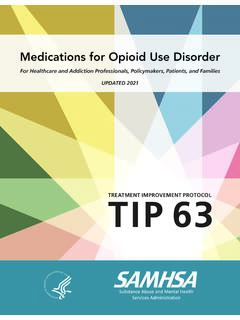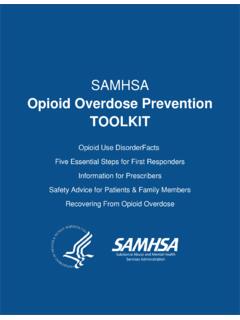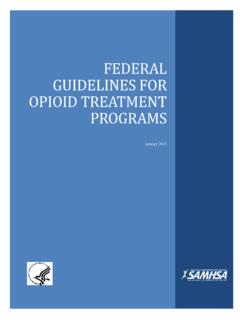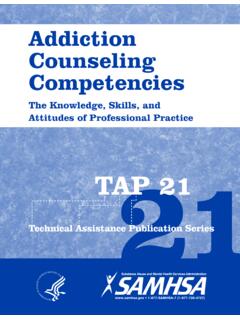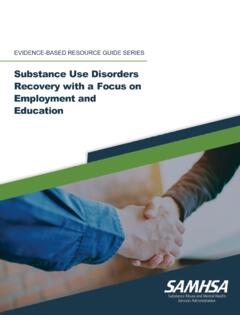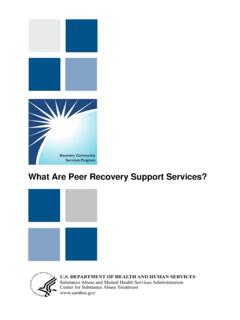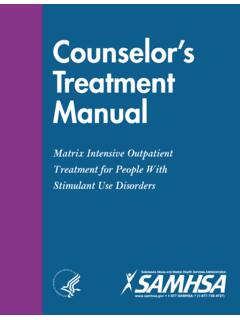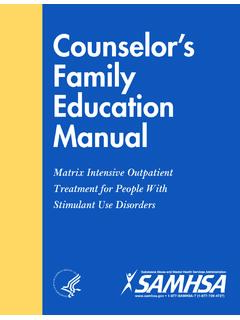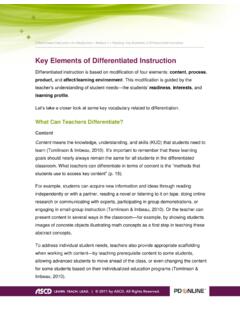Transcription of Evidence-Based and Culturally Relevant Behavioral Health ...
1 Substance Abuse and Mental HealthServices AdministrationNNEDL earn Implementation AnalysisEvidence-Based and Culturally RelevantBehavioral Health Interventions in Practice: Strategies and Lessons Learnedfrom NNEDL earn (2011-2020) ACKNOWLEDGEMENTS AND DISCLAIMERS NNEDL earn Implementation Analysis Evidence-Based and Culturally Relevant Behavioral Health Interventions in Practice: Strategies and Lessons Learned from NNEDL earn (2011-2020) Acknow ledgem ents This report was prepared for the Substance Abuse and Mental Health Services Administration (SAMHSA) under contract number HHSS283201700075I/HHSS28342001T with SAMHSA, Department of Health and Human Services (HHS). Nadine Benton served as contracting officer representative and Victoria Chau served as the task lead. Dis cla im er The views, opinions, and content of this publication are those of the author and do not necessarily reflect the views, opinions, or policies of SAMHSA.
2 Nothing in this document constitutes a direct or indirect endorsement by SAMHSA of any non-federal entity s products, services, or policies. Public Dom ain Noti ce All material appearing in this publication is in the public domain and may be reproduced or copied without permission from SAMHSA. Citation of the source is appreciated. However, this publication may not be reproduced or distributed for a fee without the specific, written authorization of the Office of Communications, SAMHSA, HHS. Elect ronic Acce ss and Printed Copie s Products may be downloaded at Products available in print may be ordered at or by calling SAMHSA at 1-877-SAMHSA-7 (1-877-726-4727). Recom m ended Cita tion Substance Abuse and Mental Health Services Administration: NNEDL earn Implementation Analysis: Evidence-Based and Culturally Relevant Behavioral Health Interventions in Practice: Strategies and Lessons Learned from NNEDL earn. PEP21-05-02-001MD: Office of Behavioral Health Equity, Substance Abuse and Mental Health Services Administration, 2021.
3 Orig inating Offi ce Office of Behavioral Health Equity, Substance Abuse and Mental Health Services Administration, 5600 Fishers Lane, Rockville, MD 20857, SAMHSA Publication No. PEP21-05-02-001. Published 2021. Nondis cr im inat ion Noti ce SAMHSA complies with applicable Federal civil rights laws and does not discriminate on the basis of race, color, national origin, age, disability, or sex. SAMHSA cumple con las leyes federales de derechos civiles aplicables y no discrimina por motivos de raza, color, nacionalidad, edad, discapacidad o sexo. Publication No. PEP21-05-02-001 Released June 2021 i NNEDL earn Implementation Analysis Evidence-Based and Culturally Relevant Behavioral Health Interventions in Practice: Strategies and Lessons Learned from NNEDL earn (2011-2020) EXECUTIVE SUMMARY Despite decades of research on effective interventions, Behavioral Health disparities continue to negatively affect black, indigenous, and other communities of color.
4 The Behavioral Health fields can do more to address these inequities by creating and providing high quality and Culturally appropriate services to specific racial and ethnic groups while also demonstrating effectiveness in improving targeted outcomes. An increased attention on using Evidence-Based practices (EBPs) as a measure of high quality care has led practitioners to favor Evidence-Based models because they are shown to be effective through outcome studies. While the concept that EBPs would be the most effective intervention seems sound, in theory, the reality is that implementing EBPs with racial and ethnically diverse populations yields many challenges. These challenges can be addressed by a number of factors, including: 1) having individuals from specific racial and ethnic groups adapt existing EBPs or develop their own interventions based on community-defined evidence; 2) ensuring the inclusion of racially and ethnically diverse individuals in the outcome studies, and building the capacity of the Behavioral Health workforce to implement existing Culturally appropriate interventions.
5 Since 2011 SAMHSA s Office of Behavioral Health Equity (OBHE) has been addressing the aforementioned challenges, in part, through its National Network to Eliminate Disparities in Behavioral Health annual training (NNEDL earn) that teaches teams of practitioners from community-based organizations who serve black, indigenous, and other communities of color in implementing Culturally Relevant evidence-supported Behavioral Health practices. To assess the impact of the training on the alumni, qualitative interviews were conducted with a sample of nine alumni and six trainers whose organization participated in NNEDL earn during the period of 2011-2020. The evidence-supported practices included in the analysis are listed below. 1 Achieving Whole Health Adapted for Asian Americans, Native Hawaiians, and Pacific Islanders 2 Familia Adelante Developed for Latino youth and parents/caregivers 3 Motivational Interviewing Appropriate for Culturally diverse populations 4 Preventing Long-term Anger and Developed for black male youth Aggression in Youth 5 Prime Time Sister Circles Developed for black women ages 40-75 6 Project Venture Developed for American Indian and Alaska Native Youth ii The findings from the analysis are summarized in this report in a case study format for each of the six practices.
6 Each case study highlights organizational strategies to address challenges and successfully implement and sustain the practices over time, particularly within the context of the communities they serve. This report is specific to NNEDL earn, from 2011 to 2020. The sum m ary of f in dings ac ross al l pr actice s There is an evident need for Culturally Relevant Behavioral Health practices, as reported by how well they were received by service recipients and how well it aligned with the organizations mission. These two factors, filling a service need and alignment with organizational priorities, helped gain the support of executive leaders that all respondents agreed was essential to sustaining and scaling the practice. Tracking outcomes was another factor that facilitated leadership buy-in and created opportunities for funding and partnerships. Having congruence between the service provider and recipient on key demographic factors greatly facilitates implementation.
7 The exact demographic factors varied by program but included age, gender , and race and ethnicity. Alumni attribute successful implementation to the flexibility that the practices allowed them to make some degree of customization to meet the needs of specific racial and ethnic groups. The degree of permissible adaptations varied by program. It helped that alumni could make calculated adaptations due to the training, which helped ground them in the theoretical basis of the model and provided access to the trainer/developer. Alumni face varying challenges, including the need to address barriers to participation. The most common barriers included transportation and childcare. Solutions required partnering with other organizations, securing grant funding, and leveraging internal funds. Alumni need ongoing support as they make adaptations to ensure fidelity to the model. Alumni who are scaling up the practice could benefit from a train-the-trainer training to better support those efforts.
8 In the current context, alumni face new challenges of having moved programs to a virtual platform and seek support to increase participants engagement. The findings conclude that the Culturally Relevant evidence-informed Behavioral Health practices offered through NNEDL earn appear to be having a positive impact among racially and ethnically specific communities. NNEDL earn alumni are gaining the capacity required to successfully implement and scale up the programs that expand the reach of services. Train-the-trainer strategies and movement toward virtual implementation have the potential to expand reach even further, which builds progress toward eliminating the Behavioral Health disparities for black, indigenous, and other communities of color. Future considerations for NNEDL earn include formalizing the ongoing technical assistance provided by trainers that is outside of their NNEDL earn scope of work, institute evaluations inclusive of alumni feedback on implementation challenges to inform ongoing improvements to the model, and consider supplementing training with additional resources such as on-demand video training sessions that could contribute to implementation fidelity.
9 Iii TABLE OF CONTENTS Executive 1. 1 Overview of 1 Purpose and Objectives of the Assessment .. 1 2. NNEDL earn Intervention Case 2 Achieving Whole Health : Balancing Body, Mind, and Familia Adelante: Multi-risk Reduction Behavioral Health Prevention for Latino/Hispanic Youth and Families .. 5 Motivational Preventing Long Term Anger and Aggression in 8 Prime Time Sister Circles .. 11 Project Venture: Positive Youth Development for American Indian and Alaska Native Youth .. 13 3. Summary of Strategies and Lessons Learned from NNEDL earn 15 Factors That Facilitated successful Implementation and Implications .. 15 Summary of By-Products, Achievements, or Additional Positive Outcomes .. 18 Common Challenges and Solutions to Implementation .. 18 4. Conclusion .. 20 Implications for NNEDL earn Training .. 20 Appendix A: Interview Protocols Appendix B: Summary of Implementation Strategies and Lessons Learned iv 1.
10 INTRODUCTION The Substance Abuse and Mental Health Services Administration s (SAMHSA) Office of Behavioral Health Equity (OBHE) continues its mission to reduce disparities in Behavioral Health by addressing the need to expand the capacity of the workforce in ways that improve the quality of care for underserved populations. Quality of care is assessed based on empirical evidence that determines which practices are Evidence-Based , and these become the gold standard of Behavioral Health practices. However, employing Evidence-Based models with underserved populations, including racial and ethnically diverse groups, may not always yield the best outcomes. This could be due to the variability in how the practices are implemented, especially when the person delivering the service does not have a grounding of the cultural context to make the necessary cultural adaptations to the service population. Another challenge is that many Evidence-Based practices (EBPs) were tested and validated on populations that often do not match key characteristics of underserved groups who tend to be in low-income and of different racial and ethnic backgrounds.

